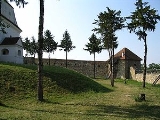
Ilieni
Encyclopedia
Ilieni is a commune located in Covasna County
, south-eastern Transylvania
, 7 km south of the county seat Sfântu Gheorghe
.
The commune is composed of three villages:
Hungarian majority. According to the 2002 census
it has a population of 1,853 of which 86.89% or 1,610 are Hungarian.
, the settlement was more important than today. The abundance of arable lands in the area (within the historical Háromszék
region), and trade relations with nearby Saxon
settlements, including Braşov
, contributed to the sound economic basis of the community.
Also resulting from its geographical location, the Székely
settlement, during its history, was often subject to foreign military campaigns. The most tragical of these attacks was in 1658, when the fortified church of the village was successfully conquered by allied Turkish and Moldavian forces, who killed all the defending fighters and threw their bodies into the well of the stronghold. Surviving villagers were taken to custody.
Since the fall of communism in 1989
, the local community has been successful in developing viable economic activities, mostly based on agriculture and food industry, but a conference centre, a youth hostel and guest houses in the area also contribute to the revival of the settlement.
Covasna County
Covasna is a county of Romania, in Transylvania, with the capital city at Sfântu Gheorghe.-Demographics:In 2002, it had a population of 222,449 and the population density was 60/km².*Hungarians – 73.79% *Romanians – 23.28%...
, south-eastern Transylvania
Transylvania
Transylvania is a historical region in the central part of Romania. Bounded on the east and south by the Carpathian mountain range, historical Transylvania extended in the west to the Apuseni Mountains; however, the term sometimes encompasses not only Transylvania proper, but also the historical...
, 7 km south of the county seat Sfântu Gheorghe
Sfântu Gheorghe
Sfântu Gheorghe is the capital city of Covasna County, Romania. Located in the central part of the country and in the historical region of Transylvania, it lies on the Olt River in a valley between the Baraolt Mountains and Bodoc Mountains...
.
The commune is composed of three villages:
- Dobolii de Jos / Aldoboly
- Ilieni
- Sâncraiu / Sepsiszentkirály
Demographics
The commune has an absolute SzékelySzékely
The Székelys or Székely , sometimes also referred to as Szeklers , are a subgroup of the Hungarian people living mostly in the Székely Land, an ethno-cultural region in eastern Transylvania, Romania...
Hungarian majority. According to the 2002 census
Census
A census is the procedure of systematically acquiring and recording information about the members of a given population. It is a regularly occurring and official count of a particular population. The term is used mostly in connection with national population and housing censuses; other common...
it has a population of 1,853 of which 86.89% or 1,610 are Hungarian.
History
There is archaeological evidence of the area having been populated since the Bronze Age. The place was first time mentioned in a church tax inventory as "Villa Helye" in 1332. In the Middle Ages, having the rights of a market townMarket town
Market town or market right is a legal term, originating in the medieval period, for a European settlement that has the right to host markets, distinguishing it from a village and city...
, the settlement was more important than today. The abundance of arable lands in the area (within the historical Háromszék
Háromszék
Háromszék is the name of a historic administrative county of the Kingdom of Hungary. Its territory is presently in central Romania...
region), and trade relations with nearby Saxon
Transylvanian Saxons
The Transylvanian Saxons are a people of German ethnicity who settled in Transylvania from the 12th century onwards.The colonization of Transylvania by Germans was begun by King Géza II of Hungary . For decades, the main task of the German settlers was to defend the southeastern border of the...
settlements, including Braşov
Brasov
Brașov is a city in Romania and the capital of Brașov County.According to the last Romanian census, from 2002, there were 284,596 people living within the city of Brașov, making it the 8th most populated city in Romania....
, contributed to the sound economic basis of the community.
Also resulting from its geographical location, the Székely
Székely
The Székelys or Székely , sometimes also referred to as Szeklers , are a subgroup of the Hungarian people living mostly in the Székely Land, an ethno-cultural region in eastern Transylvania, Romania...
settlement, during its history, was often subject to foreign military campaigns. The most tragical of these attacks was in 1658, when the fortified church of the village was successfully conquered by allied Turkish and Moldavian forces, who killed all the defending fighters and threw their bodies into the well of the stronghold. Surviving villagers were taken to custody.
Since the fall of communism in 1989
Romanian Revolution of 1989
The Romanian Revolution of 1989 was a series of riots and clashes in December 1989. These were part of the Revolutions of 1989 that occurred in several Warsaw Pact countries...
, the local community has been successful in developing viable economic activities, mostly based on agriculture and food industry, but a conference centre, a youth hostel and guest houses in the area also contribute to the revival of the settlement.

